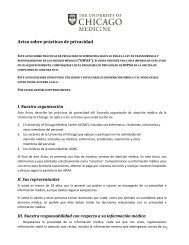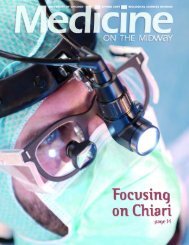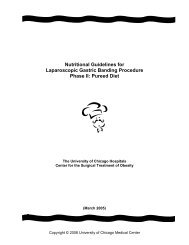Theme: Developmental BiologyIlaria Rebay, PhDAssociate Professor of The Ben May Department for Cancer ResearchThe long-term goal of the Rebay laboratory is tounderstand how cells generate, integrate, and respondto dynamic informational cues. To address this broadquestion, the laboratory uses Drosophila, and inparticular the fly eye, as a powerful model system inwhich to study cross-talk between signal transductionpathways and tissue specific transcriptional networks.Because the signaling mechanisms studied have beenhighly conserved in evolution, investigation of themolecular circuitries used in Drosophila can advancethe understanding of how cell fates are designated andmaintained in all animals, and why misregulation resultsin cancer and disease in humans. Current researchfocuses on elucidating the function and regulation oftwo independent but interconnected nuclear circuitriesoperating downstream of the receptor tyrosine kinase(RTK) pathway.Protein uptake in Tetrahymena thermophilia, a ciliated protozoan, via labelingwith a GFP-tagged protein. (Image by A. Turkewitz)First, the Rebay laboratory is studying the function andregulation of Yan, a conserved ETS family transcriptionalrepressor and RTK pathway antagonist. Reflecting critical roles in regulating cell proliferation, differentiation, and survivalduring normal development, misregulated ETS protein activity contributes via a variety of mechanisms to the initiation andprogression of many human cancers. For example, translocations involving the human counterpart of Drosophila Yan, referredto as Tel1, are among the most frequent chromosomal aberrations associated with leukemia. Both Tel1 and Yan self-associatevia an N-terminal protein-protein interaction domain called the Sterile Alpha Motif (SAM). In vitro, the isolated SAM canform homooligomers, leading to the hypothesis that polymerization might contribute to the mechanism of Tel1/Yan-mediatedtranscriptional repression. Intriguingly, in-frame fusions of the Tel1 SAM to an assortment of tyrosine kinases and transcriptionfactors are detected in the above mentioned leukemic translocations, suggesting that SAM-mediated self-association alsocontributes to oncogenesis. Thus, the specific aim of this project is to elucidate how SAM-mediated self-association regulatesnormal Tel1/Yan-mediated repression of transcriptional target genes during development. In the long-term, this knowledge mayfacilitate the design of specific molecular interventions to block the oncogenic properties of Tel1-SAM leukemic fusion proteins.The goal of the laboratory’s second project is to investigate the molecular mechanisms whereby a group of evolutionarilyconserved transcription factors, collectively termed the Retinal Determination (RD) gene network, interface with multiplesignaling pathways to direct eye specification and development. The research centers on a gene called Eyes absent (Eya),which the laboratory identified as a node of cross-talk between the RD network and the Epidermal Growth Factor RTKsignaling pathway. The Rebay group discovered that in addition to its role as a transcription factor, Eya functions as a proteintyrosine phosphatase. Both functions are required for Drosophila eye development, and perturbation of either activity leads todevelopmental abnormalities in mammals. RD genes, either individually or as a network, also regulate proliferation and cell fatespecification in a diverse array of developmental contexts in all metazoans, and consequently both increased expression andloss of gene function results in developmental perturbation and disease. For example, reduced Eya function results in ear, eye,kidney, heart and cranial-facial defects, whereas upregulation of Eya proteins appears to correlate with poor clinical outcome inpatients with epithelial ovarian cancer. Thus, a primary aim of this work is to elucidate the specific developmental contexts andsignaling pathways in which Eya participates, and how its dual functions are coordinated and coregulated.16UCCRC SCIENTIFIC REPORT 2009
Most recently, the laboratory discovered that subcellular partitioning of Eya protein between nucleus and cytoplasm iscritical for normal eye development and that phosphatase function is predominantly required in the cytosol. Cooperativeinteractions between Eya and the Abelson (Abl) tyrosine kinase were found to be critical for photoreceptor axon guidance inthe Drosophila visual system, and that mechanistically, Abl-mediated phosphorylation of Eya provides a critical cytoplasmicretention signal that presumably recruits Eya phosphatase activity to relevant signaling complexes. Abl is well-known as apotent oncogene, and its normal role in regulating actin cytoskeleton dynamics suggests that further investigation of Eya-Ablinteractions may provide new insight into the signaling networks regulating cell adhesion, motility, and invasiveness.Cell Signaling &Gene RegulationGeoffrey Greene, PhDProfessor of The Ben May Department for Cancer ResearchThe overall goal of research in Dr. Greene’s laboratory is to elucidate the molecular mechanisms by which female steroidhormones regulate development, differentiation, cellular proliferation and survival in hormone responsive tissues andcancers, especially breast cancer. Estrogens modulate the expression of diverse regulatory proteins and growth factors viaone or both of two estrogen receptor subtypes (ERα and ERβ). The Greene laboratory is actively studying multiple aspects ofER action, using a combination of in vitro, cell-based, and animal models.Current areas of focus include: 1) Defining the molecular/structural mechanisms by which selective estrogen receptormodulators (SERMs) elicit tissue-selective agonist or antagonist responses via one or both ER subtypes; 2) identifying novelER subtype-selective SERMs via a combination of structure-based drug design and de novo drug discovery; 3) characterizinga mouse knock-in model in which a mutated ERα does not recognize endogenous estrogens, but will respond to exogenoussynthetic ligands; 4) identifying the relative contributions and mechanisms of transcriptional versus rapid, nongenomic ERαactions in estrogen target tissues; 5) developing targeted nanoparticles for imaging and therapeutic applications, especiallyin breast/prostate cancers; 6) genome-wide mapping and characterization of ERα/β target genes (ER transcriptome); and 7)identification and characterization of protein components of the ER interactome. All of these projects have direct relevanceand application to breast and uterine cancer genesis, progression, treatment and prevention, as well as to the development ofcompounds that can be used for hormone replacement therapy in postmenopausal women.The laboratory recently generated an estrogen non-responsive estrogen receptor knock-in (ENERKI) mouse model to studythe role of ERα during endocrine and neuroendocrine development and mammary tumor genesis. The mutant ERα (G525L)that was introduced by gene replacement into these mice does not recognize endogenous estrogen but does recognizeexogenous synthetic estrogen agonists and antagonists, such as diethylstilbestrol (DES), propyl pyrazole triol (PPT) and4-hydroxytamoxifen (OHT). Mutant ERα can be turned on or off simply by giving mice DES or PPT, both potent estrogens.ERα signaling pathways that do not require ligand remain intact, allowing them to study these pathways as well. FemaleENERKI mice had hypoplastic uterine tissues and rudimentary mammary gland ductal trees. Females were infertile due toanovulation, and their ovaries contained hemorrhagic cystic follicles because of chronically elevated levels of LH.The ENERKI phenotype confirmed that ligand-induced activation of ERα is crucial in the female reproductive tract andmammary gland development. Growth factor treatments induced uterine epithelial proliferation in ovariectomized ENERKIfemales, directly demonstrating that ERα ligand-independent pathways were active. PPT treatments initiated at pubertystimulated ENERKI uterine development, whereas neonatal treatments were needed to restore mammary gland ductalelongation, indicating that neonatal ligand-induced ERα activation may prime mammary ducts to become more responsive toestrogens in adult tissues. This mouse is a useful model for in vivo evaluation of ligand-induced ERα pathways and temporalpatterns of response. Interestingly, DES did not stimulate an ENERKI uterotrophic response, possibly due to the upregulationof ERβ in ENERKI mice, which is exerting an antiproliferative function in the uterus. It remains to be determinedif the mammary gland is similarly affected by DES treatment. ENERKI mice will be crossed with several mouse modelsthat develop spontaneous mammary tumors to better understand the role of endogenous estrogen and ERα in mammarycancer genesis and progression. This model should also prove useful for studying the estrogen-mediated development andhomoeostasis of the reproductive tract, bone, cardiovasculature and central nervous system.UCCRC SCIENTIFIC REPORT 200917
- Page 1 and 2: Collaborate Explore Discover2008-20
- Page 3 and 4: Immunology& CancerClinical & Experi
- Page 6 and 7: AdministrationUCCRC Executive Commi
- Page 8 and 9: Program 1Cell Signaling and Gene Re
- Page 10 and 11: 8MembersInvestigator*Kenneth Alexan
- Page 12 and 13: Theme: Molecular Mechanisms of Apop
- Page 14 and 15: Theme: Cell Motility, Cell-Cell Adh
- Page 16 and 17: Theme: Systems Biology and Genetic
- Page 20 and 21: Additional Program Highlights*Resea
- Page 22 and 23: Selected Publications* : Intraprogr
- Page 24 and 25: Lang D, Mascarenhas JB, Powell SK,
- Page 26 and 27: Granovsky AE, Rosner MR. Raf kinase
- Page 28 and 29: Selected Major Grants and AwardsThe
- Page 30 and 31: Program 2Molecular Genetics and Hem
- Page 32 and 33: MembersInvestigator*John Anastasi M
- Page 34 and 35: Theme: Pathogenesis of LeukemiaDoro
- Page 36 and 37: The ultimate goals of the laborator
- Page 38 and 39: Additional Program Highlights*Resea
- Page 40 and 41: Selected Publications* : Intraprogr
- Page 42 and 43: * Knight JA, Skol AD, Shinde A, Has
- Page 44 and 45: * # Gordon MK, Sher D, Karrison T,
- Page 46 and 47: Program 3Immunology and CancerScann
- Page 48 and 49: MembersInvestigator*Erin Adams PhDM
- Page 50 and 51: and αβ TCRs are well known, the l
- Page 52 and 53: transcriptional profile in the tumo
- Page 54 and 55: ••The impact of regulatory T ce
- Page 56 and 57: Selected Publications* : Intraprogr
- Page 58 and 59: Storb, Ursula MD# Longerich S, Orel
- Page 60 and 61: Dr. Susan Cohn with a patientProgra
- Page 62 and 63: 60MembersInvestigator*Douglas Bisho
- Page 64 and 65: compared to mice treated with IP ci
- Page 66 and 67: Using a structure-based rationale,
- Page 68 and 69:
incorporation of other genetic elem
- Page 70 and 71:
Additional Program Highlights*Resea
- Page 72 and 73:
Selected Publications* : Intraprogr
- Page 74 and 75:
Hart, John MD* # Dougherty U, Sehde
- Page 76 and 77:
Nanda, Rita MD# Wei M, Xu J, Dignam
- Page 78 and 79:
# Yang C, Karczmar GS, Medved M, Ot
- Page 80 and 81:
Selected Major Grants and AwardsThe
- Page 82 and 83:
Program 5Advanced Imaging
- Page 84 and 85:
MembersInvestigator*Hiroyuki Abe MD
- Page 86 and 87:
in as many as 86% of the measuremen
- Page 88 and 89:
investigators and engineers from co
- Page 90 and 91:
have important clinical implication
- Page 92 and 93:
Theme: Image-Guided TherapyCharles
- Page 94 and 95:
irradiated to a variety of doses ne
- Page 96 and 97:
Selected Publications* : Intraprogr
- Page 98 and 99:
* Jansen SA, Fan X, Karczmar GS, Ab
- Page 100 and 101:
Program 6Cancer Risk and Prevention
- Page 102 and 103:
MembersInvestigator*Habibul Ahsan M
- Page 104 and 105:
to prostate cancer. The work has ma
- Page 106 and 107:
Dr. Ahsan’s team showed that sele
- Page 108 and 109:
Theme: Psychological and Bio-Behavi
- Page 110 and 111:
Daniel McGehee, PhDAssociate Profes
- Page 112 and 113:
Sarah Gehlert, PhDProfessor of the
- Page 114 and 115:
Selected New Funding•• Lisa San
- Page 116 and 117:
Selected Publications* : Intraprogr
- Page 118 and 119:
Gehlert, Sarah PhD* Gehlert S, Sohm
- Page 120 and 121:
Olopade, Olufunmilayo MBBS* Bradbur
- Page 122 and 123:
Clinical Trials ActivityDr. Alessan
- Page 124 and 125:
The clinical trials activity of the
- Page 126 and 127:
Shared ResourcesDr. Vytas Bindokas
- Page 128 and 129:
Biostatistics Core FacilityScientif
- Page 130 and 131:
collaborations. The Facility mainta
- Page 132 and 133:
The services provided include:•
- Page 134 and 135:
Other Resources and Centers
- Page 136 and 137:
Cancer Resource CenterThe UCCRC off
- Page 138 and 139:
CECOS has successfully developed an
- Page 140 and 141:
Committee on ImmunologyThe Committe
- Page 142 and 143:
The University of Chicago Medical C
- Page 144 and 145:
HighlightsThe Gwen and Jules Knapp
- Page 146 and 147:
Leukemia and Lymphoma Society Speci
- Page 148 and 149:
Institute for Genomics and Systems
- Page 150 and 151:
Systems Biology Approach for the St
- Page 152 and 153:
Immunology and Cancer ProgramMaria-
- Page 154 and 155:
Cancer Risk and Prevention ProgramA
- Page 156:
www.uccrc.uchicago.eduEditor: Hoyee
















